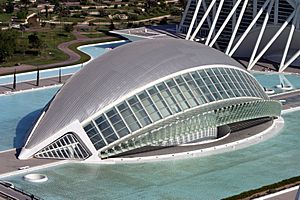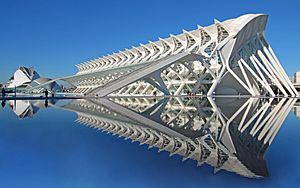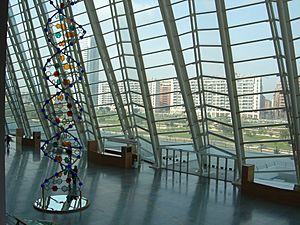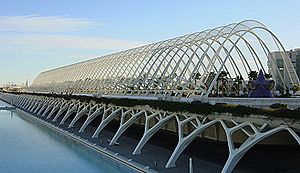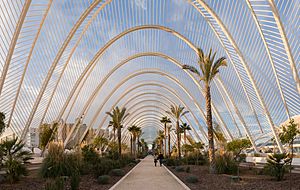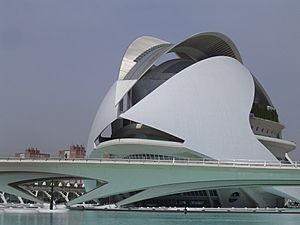City of Arts and Sciences facts for kids
The City of Arts and Sciences (Catalan: Ciutat de les Arts i les Ciències; Spanish: Ciudad de las Artes y las Ciencias) is an entertainment-based cultural and architectural complex in the city of Valencia, Spain. It is the most important modern tourist place in the city of Valencia. It is one of the 12 Treasures of Spain.
The City of Arts and Sciences is situated at the end of the former riverbed of the river Turia, which was drained and rerouted after a catastrophic flood in 1957. The old riverbed was turned into a picturesque sunken park.
The project began the first stages of construction in July 1996, and was inaugurated April 16, 1998 with the opening of L'Hemisfèric. The last great component of the City of Arts and Sciences, El Palau de les Arts Reina Sofia, was inaugurated on October 9, 2005, Valencian Community Day. It has cost nearly three times the initial expected cost.
Buildings
The complex is made up of the following buildings, in order of their inauguration:
- L'Hemisfèric (1998) — an IMAX Cinema, planetarium and laserium. The building is meant to resemble a giant eye. The Hemesferic also known as the planetarium or the “eye of knowledge,” is the centerpiece of the City of Arts and Sciences. It was the first building completed in 1998. Its design resembles an eyelid that opens to access the surrounding water pool. The bottom of the pool is glass, creating the illusion of the eye as a whole.
- El Museu de les Ciències Príncipe Felipe (2000) — Is an interactive museum of science that resembles the skeleton of a whale. It occupies three floors. The hotch-potch of exhibits is designed more for 'entertainment value' than for science education. Much of the ground floor is taken up by a basketball court sponsored by a local team and various companies.
The building is used for exhibitions. The first floor has a view of the Turia Garden that surrounds it; which is over 13,500 square meters of water. The second floor hosts “The Legacy of Science” exhibition. The third floor is known as the “Chromosome Forest” which shows the sequencing of human DNA. Also on this floor is the “Zero Gravity,” the “Space Academy,” and “Marvel Superheroes” exhibitions.
The building’s architecture is known for its geometry, structure, use of materials, and its design around nature. The building is currently the largest in Spain. This magnificent building stands 220 meters long, 80 meters wide and 55 meters high.
- L'Umbracle (2001) — an open structure enveloping a landscaped walk with plant species indigenous to Valencia (such as rockrose, lentisca, rosemary, lavender, honeysuckle, bougainvillea, palm tree). It harbors in its interior The Walk of the Sculptures, an outdoor art gallery with sculptures by contemporary artists. It was designed as an entrance to the City of Arts and Sciences.
- L'Oceanogràfic (2003) — an open-air oceanographic park, designed by Félix Candela. It is the largest oceanographic aquarium in Europe with 110,000 square meters and 42 million liters of water. It was built in the shape of a water lily.
Each building represents different aquatic environments including the Mediterranean, Wetlands, Temperate and Tropical Seas, Oceans, the Antarctic, the Arctic, Islands and the Ted Sea. This aquarium is a home to over 500 different species including dolphins, belugas, saw-fish, jellyfish, starfish, sea urchins, walruses, sea lions, seals, penguins, turtles, sharks,and rays. It also inhabits wetland bird species.
- El Palau de les Arts Reina Sofia (2005) — an opera house and performing arts center. It contains four large rooms: a Main Room, Magisterial Classroom, Amphitheater and Theater of Camera. It is dedicated to music and the scenic arts. It holds many events such as opera, theatre and music in its auditoriums.
- El Pont de l'Assut de l'Or (2008) — a white cable-stayed bridge crossing the dry Turia riverbed, connecting the south side with Minorca Street, in between El Museu de les Ciències and L'Agora. The tower of the bridge at 125 meters high is the highest point in the city.
- L'Àgora (2009) — a covered plaza in which concerts and sporting events (such as the Valencia Open 500) are held. The Agora is a space designed to hold a variety of events such as concerts, performances, exhibitions, conventions, staging of congresses, and international sports meetings.
In popular culture
Some portions of the area were featured in the 2013 racing game Gran Turismo 6 as a photo location. Exterior scenes in the futuristic city in the 2015 film Tomorrowland were filmed around the City of Arts and Sciences. In 2016 it was also used as a filming location in the sci-fi series Doctor Who, appearing in the second episode of the tenth series.
Images for kids
-
Santiago Calatrava in 2010
See also
 In Spanish: Ciudad de las Artes y las Ciencias para niños
In Spanish: Ciudad de las Artes y las Ciencias para niños



